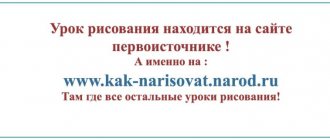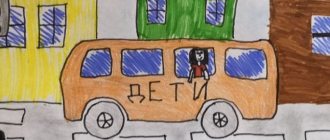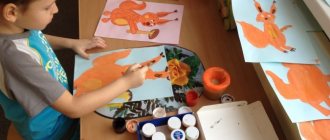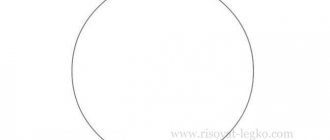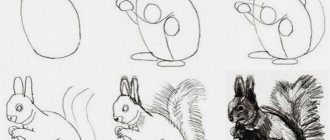Drawings about sports, step by step
Option #1: Gymnast
- We draw several approximately identical circles on the sheet. They should be located in one line at a slight angle.
- We depict the contours of the gymnast’s body and the hands with which she holds the ball. Everything should look schematic at this stage:
- Now the contours need to be shaped:
- When all parts of the body are clearly marked, draw a bold pencil on the face, arms, legs and torso. We also draw the gymnast’s hair:
- Add shadows to the drawing and remove all unnecessary lines:
Option #2: Skier
- We make sketches of the geometric shapes of a person who is standing on skis in a “half-sitting” position:
- Next you need to draw the skier’s suit, his helmet with boots and, of course, his skis:
- Now on the costume you need to draw shading and other elements that you consider necessary:
- All that remains is to shade in the right places and the skier is ready:
On the topic: methodological developments, presentations and notes
Plan of drawing notes (preparatory group) on the topic: “Winter Landscape” using the non-traditional “Imprint” technique (drawing with vegetables).
Goal: To consolidate children’s knowledge about wild animals; Objectives: Communicative and personal objectives: to activate vocabulary on the topic “Wild Animals”; learn to answer questions with complete answers.
Notes on drawing using non-traditional techniques.
Program content: Learn to depict various types of transport, their shape, structure, proportions (ratio of parts by size), consolidate the ability to easily draw an outline with a simple pencil and fill.
Program content: Learn to depict various types of transport, their shape, structure, proportions (ratio of parts by size), consolidate the ability to easily draw an outline with a simple pencil and fill.
Program content: • To form in children an aesthetic vision of nature in works of fine art, to evoke an emotional response to the beauty of nature in winter.
Source
Drawing a sport, step by step
Option #1: Snowboarding
- First we draw the snow itself. This is a regular board rounded at both edges. It should be slightly tilted to give the impression that the athlete is performing some kind of maneuver in the drawing. You need to immediately draw the head; it is located at the same level as the upper edge of the snowboard. Please note that the athlete’s legs should also be slightly visible.
- Draw the shins. The athlete’s legs will not be completely visible, since in the picture he is depicted in a “half-sitting” position.
- We round the knees and draw a helmet with a mask on the head.
- We sketch out the markings of how the shoulders and arms should be positioned. Note that one hand is free, which will reflect how the athlete maintains balance, and with the other he holds on to the snowboard.
- We detail the drawing - add facial features and clothing elements.
Option #2: Speed skating
- First, we draw the skater’s body using ordinary lines and simple geometric shapes.
- We add additional lines to the lines indicating the athlete’s body so that the arms and legs are clearly distinguished. At the same stage we draw the hat, nose and mouth.
- We add eyes on the face, draw ears, as well as lines on the tracksuit of the hero we are portraying. We also draw the skates with simple lines so that their frame is clearly visible.
- We detail the drawing with different elements, and then color it at our discretion.
Drawing about sports in pencil, step by step
Drawings about sports are not only images of sports attributes, they are also people who have achieved great success in sports. We invite you to draw a champion boxer:
- We sketch out the main elements in the figure - these are parts of the body:
- Draw the athlete's face. Here you need to remember the main rule - the person’s nose is drawn clearly in the center in relation to the eyebrow line and chin. In other words, the nose is the point of intersection of lines, the extreme points of which are the eyebrows and chin:
- After this, we begin drawing the lines of the body. Since this is an athlete, you need to draw every muscle and line in detail:
- Only shadows remain on the body. They are necessary so that, looking at the drawing, emotions are evoked:
Notes on drawing in the preparatory group “I am a future athlete!”
Lydia Podolskaya
Notes on drawing in the preparatory group “I am a future athlete!”
Summary of GCD for drawing in the preparatory group
on the topic: “ I am a future athlete ”
-Teach children to draw the figure of a person - an athlete .
-Develop continuous, easy movements when drawing a contour , visual control of movement;
- strengthen the ability to carefully paint over images.
-Cultivate interest in sports .
Preliminary work. Conversation about sports games and competitions. Examination of illustrations and photographs of athletes .
Materials:White paper (landscape format, colored and simple pencils)
.
Pictures of athletes .
Sports drawing competition
Every preschool institution can hold the following sports-themed drawing competition:
- Children can draw on any material, whatever they like best on the topic of sports. There is no need to limit children in anything so as not to lose their interest.
- The work may also contain some elements of arts and crafts.
- From each child you can only accept one of the best, in his opinion, work.
When the drawings are ready, they need to be hung in the most visible place, but at the same time difficult for children to reach. Place the ballot box next to the drawings. Let everyone who comes to kindergarten vote. To keep everything fair, do not sign the work on the front side.
Be sure to hold similar competitions in educational institutions in order to promote a healthy lifestyle, develop the creative abilities of children and form the correct model of behavior for each child. Don’t forget to lead by example so that results can be achieved quickly and efficiently!
Children 1-3 years old
Card index of morning exercises for children from 1 year to 2 years
Children 5-6 years old
The latest findings support the social validity of motivational and yoga interventions, suggesting that other middle schoolers may find these approaches worth adopting. However, given the difference in improved performance between brief yoga and motivational interventions, motivational group intervention is highly recommended.
The motivational intervention developed appears to be fun and is consistent with modern motivational strategies implemented in team sports, but so far this research has not been empirically validated - for example, teams jumping and dipping in a tight circle while shouting motivational statements before a basketball or football game. Effectiveness of a motivational group intervention The results shown in this study are also consistent with the results of other outcome measures involving athletic mental training interventions.
Rules of conduct for preschoolers in the gym
Plan for the theme day “Sports in our lives” for children 5-6 years old in winter Goal:
Introduction to the concept of sport, the importance of sport in a person’s life
Age:
senior group
Date:
mid-January Interaction of teachers: the theme day is conducted by the group’s teachers and a physical education instructor
. The plan for the theme day “Sport in our lives” is presented in the table.
For example, a controlled study by Theodorakis et al. found that endurance tasks were positively influenced by motivational statements. Miller and Donohue also showed that runners benefited after they listened to motivational statements on a CD. The latter intervention is practical because all cross country team members can benefit from using their own personalized motivational CD. Likewise, the motivational intervention developed in this study can be used to place a team of runners on treadmills and is cost-effective.
Presented:
Regular moments:
- morning reception - reading fiction - artistic and aesthetic development - physical development - afternoon
Forms of work:
- conversation (educator) - morning exercises (physical education instructor) - reading (educator) - drawing (educator) - walking lesson (physical education instructor) - didactic game (educator) - conversation (educator)
Topics:
- “What is sport” using a guest hero (Olympian Bear), illustrations about sports, literary words (Appendix 1) - Complex No. 7 with a hoop (Appendix 2) - “Two Brothers” N.Yu.
Smirnova (Appendix 3) - “Children in the gym” - “Health ski track” (Appendix 4) - “Which athlete” (Appendix 5) - “What did we learn about sports today” Objectives :
Conversations No. 1 1. Introduce children to the meaning sports in human life. 2. Form a positive attitude towards sports. 3. Cultivate interest in sports Morning exercises 1. Foster in children the habit of doing physical exercise every day Readings: 1. Learn to analyze the character and actions of heroes 2. Develop the ability to compare, generalize, draw conclusions 3. Form ideas about the need to play sports Drawings: 1. Learn to depict scenes from the surrounding life based on observations 2. Express your attitude to physical education and sports in a drawing
Physical education lesson: 1. Continue to introduce children to winter sports 2. Teach sliding steps on a ski track 3. Practice the technique of descending a slope in a low stance 4. Enjoy winter sports, form the habit of a healthy lifestyle Didactic game: 1 To consolidate children's knowledge about sports, name the athlete's equipment Conversations No. 2 1. Summarize the thematic day 2. Form the concept that playing sports is good for human health
Although this study attempted to create a competitive performance evaluation environment, it should be emphasized that the tests were contrived. It is likely that the motivational intervention developed will be effective in real-life meeting situations and perhaps in other team sports such as baseball, basketball, and volleyball. Indeed, motivational interventions can be enhanced during meetings, as motivation is particularly important for performance in competitive situations.
However, such a generalization is not possible given the inherent problems in this methodology. Thus, future research will need to evaluate the developed motivational group in competitive situations. Understanding psychological preparation for sports: theory and practice.
Applications:
Annex 1
Conversation “What is sport” Progress of the conversation: Educator: - Guys, look who came to us.
This is Olympian Bear. Hello, Mishenka. Misha the Olympian: - Good morning, guys. I came running to you from training. I want to ask you, do you know what sport is and why we need it? (children's answers) The file contains the full text of the conversation Mishka stays for morning exercises Appendix 2
The file contains a complex of gymnastics with a hoop
Appendix 3
Just recently we celebrated the New Year, and this is the story I heard from N.Yu.
Smirnova “Two Brothers” Once upon a time there were two boys - Vitya and Zhenya. Vitya looked like Zhenya, and Zhenya looked like Vitya like two peas in a pod, because they were twin brothers. Yes, their hair was brown, their eyes were blue, and they were the same height. But for some reason Vitya grew up cheerful, cheerful, cheerful, and Zhenya grew up sad, tired, lethargic. This happened to the brothers because one of them loved to harden himself, did exercises in the morning, and was often in the fresh air. And his brother in the morning, instead of doing morning exercises, liked to sleep longer, instead of dousing himself with cold water, he liked to eat five cakes, instead of walking, he liked to play on the computer. In general, I did anything but physical education... The file contains the full text of the story Appendix 4
Synopsis of a physical education lesson Health ski track
Development and initial evaluation of two promising mental preparation techniques in a sample of female runners. Mental training strategies, cognition and strength. Development and controlled evaluation of sports mental education strategies in high schools.
Effects of three types of instructions on mental content on skis. Content and effect of “psychological” strategies for athletes. And we played a ton of minutes to win it. Depending on the number of guests, there are three different ways to play these games. So, for example, they will have to try to get all the sprinkles from one bottle to another within a minute. Style No. 2: “Head to head.” In this style, you will select two players for each game to go forward against each other, playing the game instead of trying to beat the clock. So you give each person a bottle and see who can get the sperm out of one bottle first. The winner was the first one to finish. Again, rotate through pairs for each game, repeating players as needed. Type No. 3: Team competition. In this style, you will split your group into two teams. For each game, teams must select one player to compete head-to-head in the game against other teams. So, for example, each team will be given a bottle, and the first team to finish will receive 10 points, the second team will receive 5, etc. this works best if you have quite a few people and is a good way to get everyone involved while cheering your team on.
- In this version, one player will beat the clock for each game.
- If not, let someone else take the shot.
Your version - use any picture you want.
Part I Children, with the help of a teacher, put on skis, go to the starting position, and line up in three columns. Exercises aimed at developing a sense of balance and rhythm: 1. Spring - squat down, simultaneously swing both arms back and forth. Do it 8 times. 2. Lifting the right and left legs alternately with the ski - the leg bends at the knee. Perform 6 times with each leg. 3. Lifting the toe of the right and left ski alternately - developing dynamic balance. Perform 6 times with each leg. 4. Assume the starting position of the skier - bend your legs slightly at the knees, lean forward slightly, bend your arms at the elbows, bring them closer to the body, and group. Do it 8 times. 5. Light jumps on both legs at the same time - keep the skis parallel. Do it 8 times. Part II...
Greeting game “Our smart heads”
Having a dinosaur party, draw a picture of a dinosaur and call it feed the dinosaur.
Having a Frozen Party, put on Sven's photo and call him to feed the reindeer. They must move the jewels one by one onto the poodle until the poodle is completely covered or the pile of jewels is gone. Your version - use any shape and objects you want. Having a sea party, make it a boat, which should be covered with colored stones. Your version - this works with almost all themes. You can use a broken paper ball, use a ping pong ball for a sports party, or even a stuffed animal that goes with your theme. The player must use the broom to get the book from one side of the obstacle to the goal on the other side of the course. Your version. Same thing, just open the book to a different object that matches your theme. Use a plastic surfboard and a beach ball.
The file contains the full lesson notes
Appendix 5
Didactic game “Which athlete?” Goal: to consolidate children’s knowledge about sports, name the athlete’s equipment. Material: cards depicting equipment for various sports. Progress of the game: from the cards provided, the child chooses the equipment of a football player, hockey player, basketball player, etc., names the item, tells why it was chosen, explains why the athlete needs it
Teams have one minute to completely wrap another player or make the best overall mummy. Your version - just change the name. #6 - Cup of Fun Before playing, place a hand sticker or hand drawing on the bottom of one plastic cup. Place this plastic cup with a bunch of other plastic cups and rotate them all over so the bottom is hidden. Players must choose a cup, drink a Coca-Cola, and keep walking until they find the invisible boy.
#7 - Eat or Be Eaten Before the party, make red or orange gelatin with an object at the bottom of the bowl. The player has a minute to reach the item by swallowing the jelly, without using their hands. Your version - no changes required, just make the object suitable for your theme.


